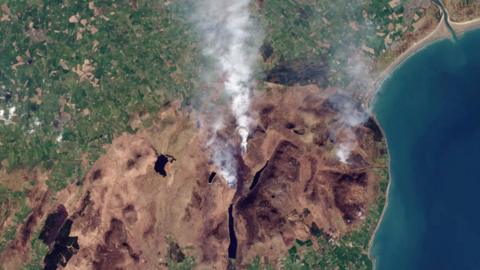These early season burns - predominantly grass, heath and shrub fires - have created great strain on fire services, but their ecological impacts can be complicated.
Not all fires, particularly smaller, lower-intensity burns, are necessarily catastrophic to long-term vegetation health.
Certain plants, such as heather, are adapted to fire-prone environments. But increasingly frequent or severe blazes can impair their ability to naturally recover.
Some researchers are concerned about the second peak of the fire season, which typically comes later in the year when temperatures are high and vegetation has dried out again.
"My number one worry is what is going to happen in the summer," said Prof Rein, when "there are fewer wildfires but they are bigger and they can actually be seriously catastrophic".
"You can have 100 [small] wildfires across the whole country and all of them can be handled in one day, or you could have one summer wildfire that actually cannot be stopped in a week and actually goes on to burn houses."
The recent widespread burns don't necessarily mean this summer will be a busy fire season.
But scientists expect the UK to see an increase in weather conditions conducive to extreme wildfires in a warming world, even though there's lots of variation from year to year.
A study led by the Met Office found that the extreme "fire weather" that helped spread the destructive blazes of July 2022 were made at least six times more likely by human-caused climate change.
Shifts in the way land is used can also play a key role in shaping fire risk.
"One thing that seems to have consensus is that we are likely to see more fires and possibly worse fires with climate change," said Rory Hadden, senior lecturer in fire investigation at the University of Edinburgh.
"We need to be prepared for this to become more common."
